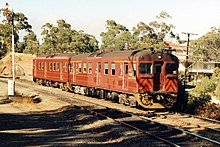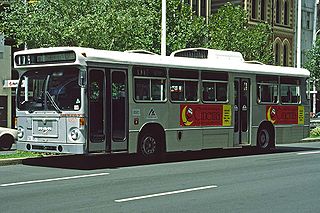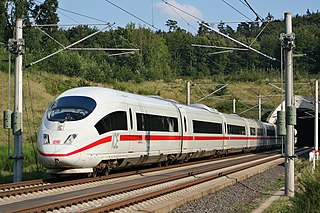
The SteamRanger Heritage Railway is a historic train society in South Australia running trains on the Victor Harbor railway line. It is the only group regularly operating broad gauge steam locomotives in South Australia. It is run by volunteers of the South Australian Division of the Australian Railway Historical Society.

The Belair railway line is a suburban rail commuter route in the city of Adelaide, South Australia, that runs from the Adelaide station to Belair in the Adelaide Hills via the Adelaide-Wolseley line.
Push–pull is a configuration for locomotive-hauled trains, allowing them to be driven from either end of the train, whether having a locomotive at each end or not.

The State Transport Authority (STA) was the government agency which controlled public transport in South Australia between 1974 and 1994.

The 620/720 class railcars were a class of Diesel Multiple Unit built by the New South Wales Government Railways and operated from 1961 until 2007.

The 2000/2100 class were a class of diesel railcars operated by the State Transport Authority and its successors in Adelaide. They were built by Comeng, Granville in 1979-1980.
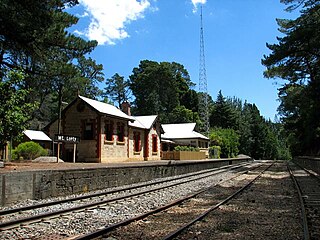
The Bridgewater railway line is a former passenger railway service on the Adelaide to Wolseley line in the Adelaide Hills. It was served by TransAdelaide suburban services from Adelaide. On 26 July 1987, the service was curtailed to Belair. In 1995, the line was converted to standard gauge as part of the One Nation infrastructure program, disconnecting these stations from the broad gauge suburban railway system.

The National Railway Museum, Port Adelaide, South Australia, is Australia's largest railway museum with over 100 exhibits on display, primarily from the Commonwealth and South Australian Railways. First opening its doors in 1970, the Museum moved to its larger and current premises in 1988.
The railways of New South Wales, Australia, use a large variety of passenger and freight rolling stock.
The Kerr Stuart steam railmotor, also known as Motor Car 3, was a steam railcar operated by the Victorian Railways from 1913 to 1924.

The DRC was a class of railmotor operated by the Victorian Railways on its country rail network in Victoria, Australia. The cars were built by Tulloch Limited in New South Wales, and featured aluminium and steel construction, air-conditioning, and twin diesel engines with hydraulic transmissions.
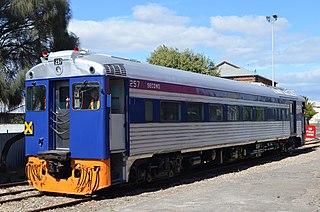
The Bluebird railcars were a class of self-propelled diesel-hydraulic railcar built by the South Australian Railways' Islington Railway Workshops between 1954 and 1959.

The South Australian Railways Model Brill railcar were two types of railcars operated by the South Australian Railways between 1925 and 1971. Introduced to run on country rail services, the "Barwell Bulls" serviced most of the state's railway lines until they were eventually replaced by both the Bluebird and Redhen railcars, with the last units withdrawn in 1971.
The 600/700 class railcars were a class of Diesel Multiple Unit built by the New South Wales Government Railways. They were built to operate on branch lines from 1949 with low traffic volumes later being transferred to Newcastle and Wollongong to operate suburban services until withdrawn in 1994. However, one 600 class railcar was converted to solar operation for use on the Byron Bay Train service. The upgraded train entered service on 16 December 2017 and is believed to be the world's first solar-powered train.

The 400 & 500 Class rail motors are diesel trains built by New South Wales Government Railways primarily for use on regional lines throughout NSW. The trains have since been phased out following a rationalisation of country branch line rail services in November 1983. The 400 Class power cars were built in 1938 at the Eveleigh Carriage Workshops, while the 500 Class trailer cars were built by Ritchie Brothers at Auburn.

A steam railcar is a rail vehicle that does not require a locomotive as it contains its own steam engine. The first steam railcar was an experimental unit designed and built in 1847 by James Samuel and William Bridges Adams. In 1848 they made the Fairfield steam carriage that they sold to the Bristol & Exeter Railway, who used it for two years on a branch line.
The 1100 class railcar or Budd railcar are a type of diesel railcar built by Commonwealth Engineering for the New South Wales Government Railways in 1961. They primarily operated on the South Coast Daylight Express until withdrawn in 1993.
